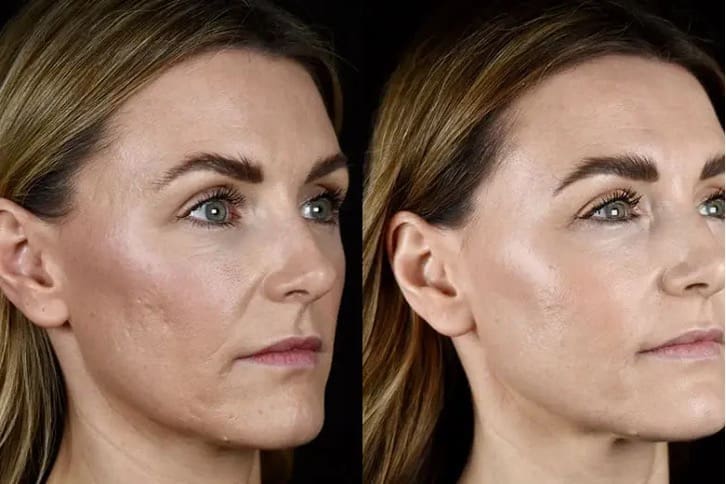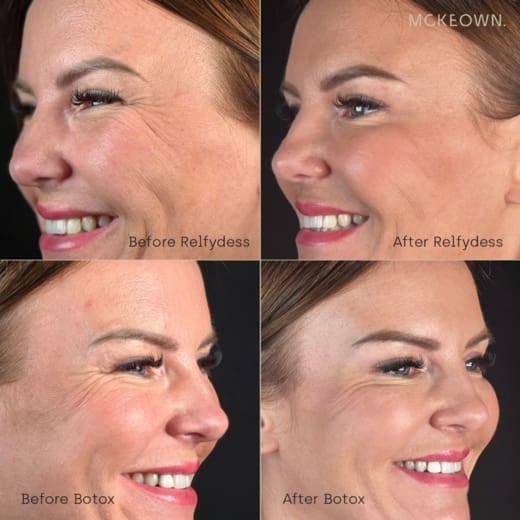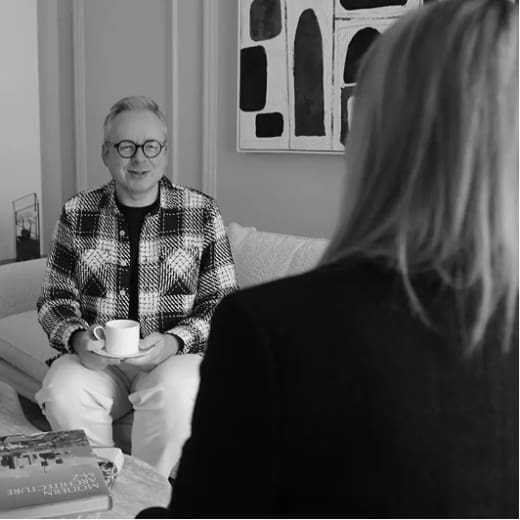McKeown Medical
167 Bath Street, Glasgow, G2 4SQ
Date posted — 11.08.25

Acne scars can feel like a stubborn reminder of a skin condition you’ve long since left behind – and one that was pretty unpleasant, we’d all rather forget. Even when your breakouts are under control, pitted marks, uneven texture, and pigmentation can affect how you feel about your skin — and, in turn, your confidence.
While no treatment can completely erase acne scars, the right approach can make a dramatic difference to skin texture, tone, and overall smoothness. Two of the most popular treatments for acne scarring are microneedling and laser resurfacing — but which is more effective for you?
Microneedling works by creating thousands of controlled micro-injuries in the skin using fine needles. This stimulates your body’s natural wound-healing process, triggering the production of collagen and elastin — the key building blocks of healthy, smooth skin.
It can be effective for superficial textural irregularities and newer scars, and can be used on most skin tones with minimal downtime.
Pros of Microneedling:
Cons of Microneedling:
Laser resurfacing uses concentrated light energy to remove damaged layers of skin and remodel collagen beneath the surface. It can treat a wide variety of acne scars, but is particularly effective for more significant scar types and complex mixed patterns that involve both texture and pigmentation.
At McKeown Medical, we offer a full suite of advanced laser technologies so we can match the treatment to your exact skin concerns:
Pros of Laser Resurfacing:
Cons of Laser Resurfacing:
Acne scars are as individual as fingerprints — no two people have exactly the same pattern, depth, or distribution. For that reason, there is no universal “best” treatment.
In many cases, combining different laser resurfacing techniques delivers the best results: different laser types can often be combined in the same session to deliver maximum results.
Our approach at McKeown Medical is to assess your skin in detail, discuss your priorities, and create a personalised treatment plan that addresses both the physical scarring and your concerns about downtime, cost, and results.
You can read more about acne scar treatment options in our guide:
➡️ Can You Get Rid of Acne Scars? Your Questions Answered
Living with acne scars can be frustrating and emotionally draining — especially when you’ve already worked hard to clear your skin. At McKeown Medical, we understand that you want maximum improvement – which is difficult to achieve – but we will guide you on the best course of treatment to get you the best results we can.
That’s why we offer a comprehensive range of laser resurfacing treatments, all carried out by a medically led team. There’s no guesswork, no one-size-fits-all packages — just a plan tailored to your skin, your scars, and your goals.
If your scars haven’t improved, or you’re not sure what your next step should be, book a consultation today. You’ll get honest advice, medical expertise, and a clear plan tailored to your skin.

When a new wrinkle-relaxing treatment comes to market, it often generates a lot of buzz but at McKeown Medical, we...

Think varicose vein treatment is painful, risky, or ineffective? Discover the truth as we debunk 5 common myths and reveal...

Struggling with acne scars? We compare microneedling and laser resurfacing to reveal which treatment smooths skin, boosts collagen, and reduces...
1 / 3
2 / 3
3 / 3

When a new wrinkle-relaxing treatment comes to market, it often generates a lot of buzz but at McKeown Medical, we...

Think varicose vein treatment is painful, risky, or ineffective? Discover the truth as we debunk 5 common myths and reveal...

Struggling with acne scars? We compare microneedling and laser resurfacing to reveal which treatment smooths skin, boosts collagen, and reduces...
Lower eyelid surgery is one of the more challenging operations in aesthetic practice. If we can avoid it, we normally try to help our patients chose non-surgical paths using laser or fillers.
However, there are some situations where it can’t be avoided, especially when there is excess fat under the eye causing puffiness. This is exactly what this patient had and so the very talented @bramhallplasticsurgery performed an upper and lower blepharoplasty for him. Whilst we often do the upper eyelids without doing the lower eyelids, usually when we do the lower eyelids we always need to do the uppers too.
This patient is now a couple of months out from surgery and loving his result. What do you think?

Laser season continues!
Thank you to this lovely patient who has kindly allowed us to share her results. She was particularly concerned about the fine lines and creases around her mouth, and underwent full-field laser resurfacing to target the deeper layers of the skin.
This is just two months after treatment and you can already see a significant improvement in the fine lines and overall skin texture. She’s still a little red and got some more healing to do, but she is already very happy with the improvement. This patient was a bit anxious about having the treatment done, so chose to have it under sedation which means she slept throughout and woke up when it was over!
What do you think?

It’s been six months since we launched the new toxin Relfydess in the clinic so, how is it going?
We’ve undertaken a survey of all of the patients we treated with the new toxin in the first month, who are now around six months since their first treatment, to find out more about what they thought of the results over the longer term - whether it kicked in faster, whether it looked better and whether they felt it lasted longer than the previous toxin.
Here are the results, and the feedback so far is really encouraging with the majority of patients reporting that it kicked in faster, looked better and lasted longer.
If you’d like to see more detail and analysis of these results, check out the link to the blog post in our profile.

Aesthetic interventions are never far from the headlines and this week the media have been focused on comments made by the make up artist Bobbi Brown about her view of cosmetic procedures. I was on BBC Radio Scotland today talking about the issue.
My own view is that we should all age in the way we feel comfortable with - if you are happy with grey hair and wrinkles, then I absolutely admire you just as much as I admire those who feel differently and want a little help to keep the signs of ageing at bay. There is no right and wrong and there is no room for moral superiority. Just you be you!
Have a listen to the debate and let me know what you think in the comments!

I’ve been back in the clinic for a week and we are right into laser season!
Thank you so much to this lovely patient who has allowed us to share her pictures with you. She was concerned about sun damage and deep lines and wrinkles on her face, especially on her forehead, on her cheeks and around her mouth. She opted for full laser resurfacing which is unrivalled for repairing this level of damage to the skin, but does come with slightly more downtime compared to other laser treatments.
These after pictures are six weeks after this patient’s initial treatment, and while she’s still a little pink (little enough that light make up will cover it!), you can see the she already has beautifully refreshed skin and her deep lines have been significantly reduced.
The true results for full laser resurfacing are usually seen after six months so we’ll share some pictures of this patient then so you can see the final result, but she’s absolutely delighted with the improvement so far!
What do you think?

We often talk about the deep plane facelift being the gold standard technique for facelift, and we’re proud to have the talented @bramhallplasticsurgery performing it in the clinic.
Here’s Russell explaining how the deep plane facelift offers longer lasting and more natural results than other techniques. By lifting and repositioning the deeper facial structures rather than just tightening the skin, this advanced approach creates a result that looks natural, moves naturally, and continues to age beautifully over time.
If you have any questions about the deep plane facelift just send us a message, or you can see more about the procedure at the link in our profile.

Our 5ml protocol is designed for patients looking for a general refresh - perfect at the earlier stages of the aging process or a gentle start for those further into the process.
This lovely patient came to us with concerns about her nose to mouth lines, some lost volume in her cheeks and her jowls. We used the 5ml protocol to give her an overall rejuvenation which gives her a really natural result that we can build on in the future.
You can a see video of this patient’s treatment at the link in our profile.
What do you think?

This patient had deep lines and folds in her face which she wanted to address as naturally as possible, so went for our signature volumetric facelift - a fully non-surgical approach but can have significant results.
With this, we want to restore natural lift, structure and definition to her face and by carefully rebuilding volume where it’s been lost, we softened her folds and lines while maintaining a completely natural expression.
The patient is delighted is really pleased with her result so far - what do you think?

Here`s another fabulous result from our amazing consultant vascular surgeon, Dr Alex Vesey.
This patient was bothered by visible varicose veins around her knee. After treatment with foam sclerotherapy the veins have been cleared, leaving behind smoother, and healthier-looking skin.
If you have varicose veins that have been bothering you, now is a great time to have them treated. We use the minimally-invasive techniques to treat both the cosmetic and medical aspects of varicose veins, and can offer effective treatments with little to no downtime.
If you’d like to know more about how we can help with varicose veins, check the link in our profile.
